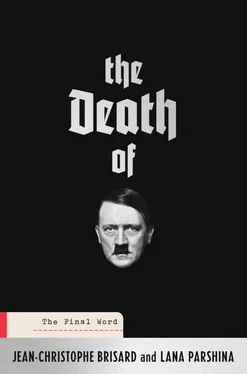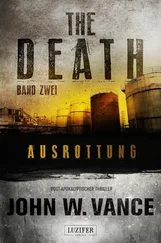For once, the FSB has reacted promptly. It’s Dmitri, the first one who replied to Lana. Dmitri, the agent of the Russian secret service who escorted us on our first visit to the Lubyanka. “Of course. No problem. Niet problème!” Lana was right. As she had imagined, a simple letter from Philippe Charlier should be enough to reassure the Russian authorities. Concise, clear, and precise, the report from the French forensic pathologist was swiftly dispatched. He repeated that he had no doubt about the identity of the teeth. They were Hitler’s. Normally, within a day or two we would receive the official letter from the FSB or the Ministry of Foreign Affairs, the agreement, the green light, a positive sign, however vague, however brief.
Nothing. Two weeks.
Then a month.
Then almost two months.
Nothing!
The same absurd and Kafkaesque routine. Lana told me over and over that her contacts had confirmed once again on the phone that we could carry out analyses. I insisted on having a written record. “Ah, a written record…?” Lana said with surprise, having suddenly fallen victim to amnesia. “I get it, I’ll send them a reminder.” And again we wait. For days.
Then, when all seemed lost, the answer came. My email. It was Alexander Orlov, our dear Alexander from the Ministry of Foreign Affairs of Mother Russia, sending me an email in French. Here, in English translation, is an extract: “It seems to me that if you analyse the particles from Hitler’s jaw that adhered to your gloves and your conclusions are not in conflict with the official position of the Russian side, we will have no right to.”
It is 7 November 2017, the leaves are turning yellow on the trees, the silent birds are saving their strength for bracing temperatures to come. I catch myself smiling. Is it exhaustion, nerves, or a lack of lucidity?
Alexander’s email appears in front of me. And I smile at it. Everything’s there. Or almost everything. “We will have no right to.” A word is missing and everything collapses. Over two months waiting for this message. Dozens of calls to Russia, reminder letters, supplications… And for what? To receive an incomplete and unusable phrase. Is it out of malice? A perverse desire to play with our resilience? Or simply a highly developed form of Muscovite administrative procrastination?
Clearly Philippe Charlier isn’t satisfied with Alexander’s message. “We will have no right to.” No right to WHAT?!!!
Dear Alexander,
Many thanks for your permission to allow us to exploit this analysis of the fragments from Hitler’s jaw.
Late afternoon: 7 November 2017. I decide to send a reminder to Alexander.
Not to annoy him. Not to vex him. Choosing my words tactfully.
“I notice the care that you have taken to reply to me in French. Nonetheless…”
Think.
“Nonetheless, a word is missing from your reply. You say: ‘We will not have the right to…’ I imagine you mean ‘the right to prevent you’ or ‘to forbid you’. Could you please just confirm?”
Lana? Nothing”! Lana is no longer in contact with the FSB, or with Alexander. The situation in Russia is becoming increasingly tense. Accusations are being made about Russian interference in the last presidential elections. No end is in sight for Syria and its military-humanitarian-religious nightmare either. The Putin regime is increasingly adopting a hard line of aggressive isolationism. Everything that comes out of the Kremlin smells of sulphur, as it did in the good old days at the height of Stalinism. And here we are benefiting from the goodwill of the Russian power that frightens so many people.
Seven days. It took Alexander seven days to pick out the right word, the most correct one, the one closest to his thoughts and send it to me. He even found several. He writes them in capital letters as if screaming them in my face: “WE WILL NOT ACCUSE (INCRIMINATE, INCULPATE) YOU.”
Now we can carry out the analyses. As far as we know, these are the first ever performed with a scanning electron microscope.
A world first.
And the hope of resolving the mystery of Hitler’s death.
“With current scientific techniques, we have the means to go much further than we could in 1945 or 1970,” Dr. Charlier says enthusiastically. “We have the means to acquire a toxicological, chemical vision of this tartar. All kinds of advantages encouraging the revelation of the truth.”
“You’ve done them all. St Louis, Richard the Lionheart, Charlemagne, Mary Magdalene… So who’s this one?”
Raphaël Weil knows Philippe Charlier very well. He’s been working with him for about ten years. He suspects that this time, yet again, the object of study for the day is a leading historical figure.
“So, which era?”
“World War Two,” the pathologist replies evasively. “The subject is a German,” he goes on. “An important historical figure, very important, even.”
Raphaël Weil looks down at the phial and sees the label with the initials “A.H.” He asks no further questions. “I’ve only got the morning,” is all he says, in a serious voice. “So let’s get going.” Of the three pieces collected, only two will be examined. The two larger ones. The less small, to be precise. The first is, at the most, 2.5 mm long by 1.3 mm thick. The second one is even thinner. But size doesn’t matter. The microscope is so powerful that it can see things on the scale of a micron. Most importantly, it will tell us the chemical composition of these tiny samples. “The idea is to have confirmation of the composition of this tartar, what was the individual’s diet, do we find only vegetable fibres, or also meat fibres? And then, last of all, I would like you to look for traces of poison.”
Not having been able to take a sample of the blue traces, Philippe Charlier hopes to collect convincing information from the tartar. Not least concerning the nature of the prostheses. “I wasn’t able to examine those prostheses at an elemental level,” he explains to Raphaël Weil. As in detective novels, the slightest detail can turn out to be the determining factor that resolves an investigation. Charlier is all too aware of this. That’s why he warns his partner: “Those prostheses were quite badly damaged, and they didn’t seem to me to be of very good quality. What I’d like you to do is to find their elemental signature. That’s essential for an understanding of a possible interaction between them and the cyanide.” In plain words, could the blue traces have been caused by a reaction between the cyanide and the metal of the prostheses? Did Hitler commit suicide by poisoning, as the Soviet investigators claimed in May 1945?
* * *
Is cyanide an effective poison? Is it painful? Hitler must have asked those questions to the doctors surrounding him in his bunker. We know that he checked its deadly effects on his dog Blondi, the Alsatian dog that he loved so much. As described earlier, he forced it to swallow a capsule. Many witnesses have described the scene. It was on 29 April 1945, in the middle of the night. Hitler no longer had any illusions about the outcome of the battle of Berlin. The Red Army was only a few streets away from his lair. In his eyes suicide was becoming the only imaginable end. But Himmler had just betrayed him by trying to negotiate directly with the Anglo-Americans; the same man who had supplied the cyanide capsules. And what if that “traitor to the Reich” had altered its composition? In a new fit of paranoia, Hitler decided to test the poison on his dog. Professor Haase, who was in charge of the hospital in the bunker, performed the macabre task with the help of the bunker’s dog handler. The animal died. The versions of this episode vary according to the witnesses. Rattenhuber, the head of the Führer’s personal guard, would later tell the Russians who took him prisoner that the dog suffered, cried out in agony and finally died after long convulsions. Hitler was profoundly shocked by the effects of the poison. Linge, Günsche, and Traudl Junge, one of Hitler’s private secretaries, agreed on a different version: after Blondi’s death, which he did not in fact witness, the Führer just acknowledged the effectiveness of the poison, showing no emotion. What is certain, on the other hand, is that the capsule worked perfectly. Was Hitler reassured? Yes, if we are to believe his entourage. He boasted of the merits of the poison to those around him. Traudl Junge reveals: “Hitler told us that death by poison was completely painless. Your nervous and respiratory systems were paralysed, and you died in a few seconds.” [62] Traudl Junge, Until the Final Hour , op. cit., p. 177.
Was he lying to his devoted followers, or did he really not know the secondary effects of cyanide? All his life Hitler was suspicious about doctors and any treatment they prescribed. He must have known the terrible truth: poisoning of that kind is fatal, but absolutely not painless.
Читать дальше












